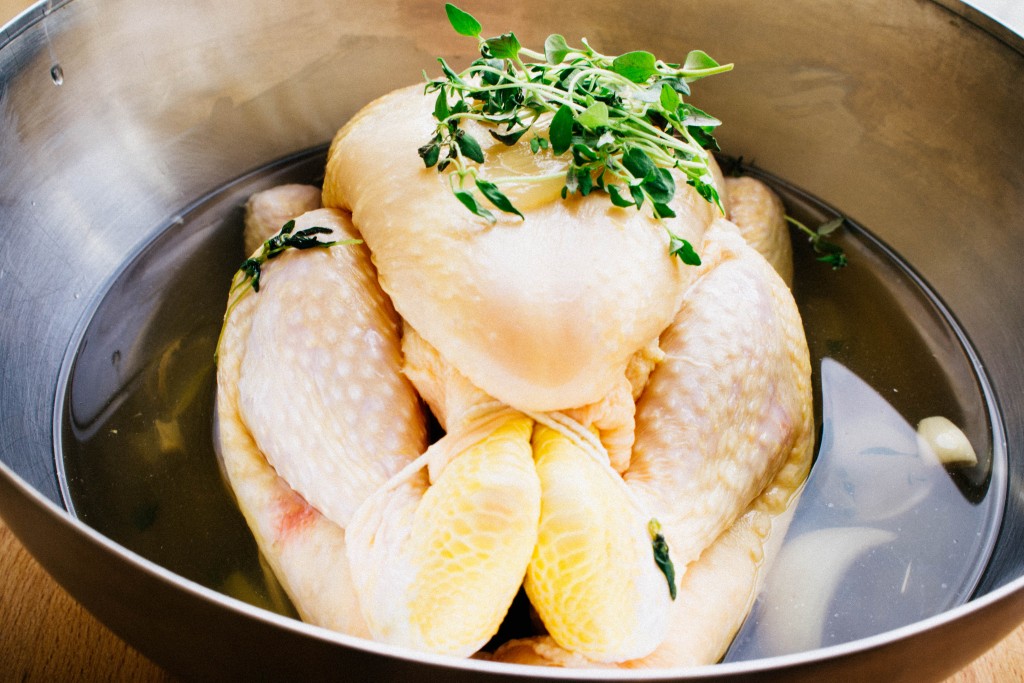 The “Rotisserie Roast Chicken” is an institution in French culture. At least, in Paris that definitely seems to be the case! I will never forget my first few months of living in Paris, and walking past the rotisseries with their chickens roasting away outside, filling the neighborhod with the delectable aroma of a perfectly-roasted chicken. You see, French rotisserie’s have a certain savoir faire that makes their roast chickens fall-off-the bone tender with that lovely rotisserie flavor. If I was feeling extra greedy, I’d go for the roasted potatoes with drippings too. It’s not uncommon to pick one up for dinner after a busy day at work, or for a Sunday family lunch.
The “Rotisserie Roast Chicken” is an institution in French culture. At least, in Paris that definitely seems to be the case! I will never forget my first few months of living in Paris, and walking past the rotisseries with their chickens roasting away outside, filling the neighborhod with the delectable aroma of a perfectly-roasted chicken. You see, French rotisserie’s have a certain savoir faire that makes their roast chickens fall-off-the bone tender with that lovely rotisserie flavor. If I was feeling extra greedy, I’d go for the roasted potatoes with drippings too. It’s not uncommon to pick one up for dinner after a busy day at work, or for a Sunday family lunch.
I’m a big believer in making things from scratch, and eating homemade everything. French roast chickens though are one of my rare exceptions! Not only are they just that good, but they’re such a good deal. In my neighborhood, they go for 5euros each! A beautifully roasted, steaming-hot chicken… for 5 euros. As in, dinner for 4 on the cheap, but still totally healthy and guilt-free when serving it to your family. A whole chicken at the grocery store is around 7euros, and you still have to prepare and cook the thing yourself. Anyway, I think I’ve spent enough time telling you about how delicious these are because unless you live there (and if you do, stop reading and go buy one now!) – you’ll have to roast our own chicken.
Today I’m going to try to help you make a Rotisserie-level roast chicken in your own kitchen, one that could hold its own against even the best chicken shops in France! If you have a rotisserie attachment for your oven then again…stop reading and go buy all the ingredients and make this immediately – with this recipe you’ll be able to duplicate the Parisian roast chicken! For the rest of us, keep reading…then run out and get the ingredients and make this, because our regular-oven version will be good too 🙂
Basic brine:
- 2 large onions, roughly chopped
- 4 cloves garlic, roughly chopped
- 100ml Salt*
- 100ml Sugar*
- 2 Litres of water
Roast chicken ingredients:
- 1 whole chicken, cleaned and all organs removed
- 1 large white onion, roughly chopped
- 1 apple, quartered
- 2 tablespoons butter, softened
- 2 tablespoons olive oil
- 4 cloves of garlic, minched
- 1 teaspoon dried thyme
- 1 teaspoon dried rosemary
- 1 teaspoon garlic powder
Instructions:
- Prepare your brine: bring about 500 ml’s of water and all of the other brine ingredients to a boil for about 5 minutes then let cool completely. Pour the boiled brine into a container big enough to submerge the chicken, add in the rest of the water, then add the chicken. Allow to brine in the fridge for around 12 hours.
- Take your brined chicken out of the water and place it in the baking dish.
- In a small bowl, mix together your butter , 1 tablespoon of olive oil, the minced and powdered garlic, and the dried herbs.
- Now, with a sharp knife, separate the skin from the meat of the chicken, being careful not to poke holes in the skin.
- Take your butter-garlic-herb mixture and spoon it (or use your hands) under the skin, evenly distributed on the chicken. It doesn’t have to be perfect, as it’ll all melt together anyway and will get into all the like nooks and crannies.
- Next, stuff the chicken with the chopped onion and apple.
- Take the remaining olive oil and spread it over the chicken.
- Season with a bit of freshly ground black pepper.
Roasting:
- Preheat your oven to 425°F, and stick the chicken in the oven for 15 minutes at this temperature to crisp the skin.
- Reduce the heat to 375°F and cook for 45-60 minutes longer, depending on your oven. Chicken is done once it reaches 165°F, and the juices run clear.
- Once cooked, remove from the oven and let rest 15 minutes before carving.
Notes:
Brining your chicken isn’t a must, but it does make a noticeable difference in the taste and texture of your chicken, and it’s much less likely to come out dry. Even if you only have enough time for a quick 60-minute brine, then do it!
I’m always worried when brining my poulty that it’ll come out too salty, so I never add as much salt as I should and I usually take it out of the brine sooner than I should. I’ve played around with it a bit, and I usually use 2 litres of water + equal parts salt & sugar (that is, 100mL of each). You should be safe with those quantities, but play around with it and experiment!
Using a meat thermometer is a must and a great investment for any home cook. This is the easiest way to know exactly when your meat is safe to eat, and prevents you from having to constantly cut in to check if the juices are running that famous shade of clear.
Check every 20 minutes or so that your chicken isn’t getting too dark, and if it is, then just cover it with some foil.
